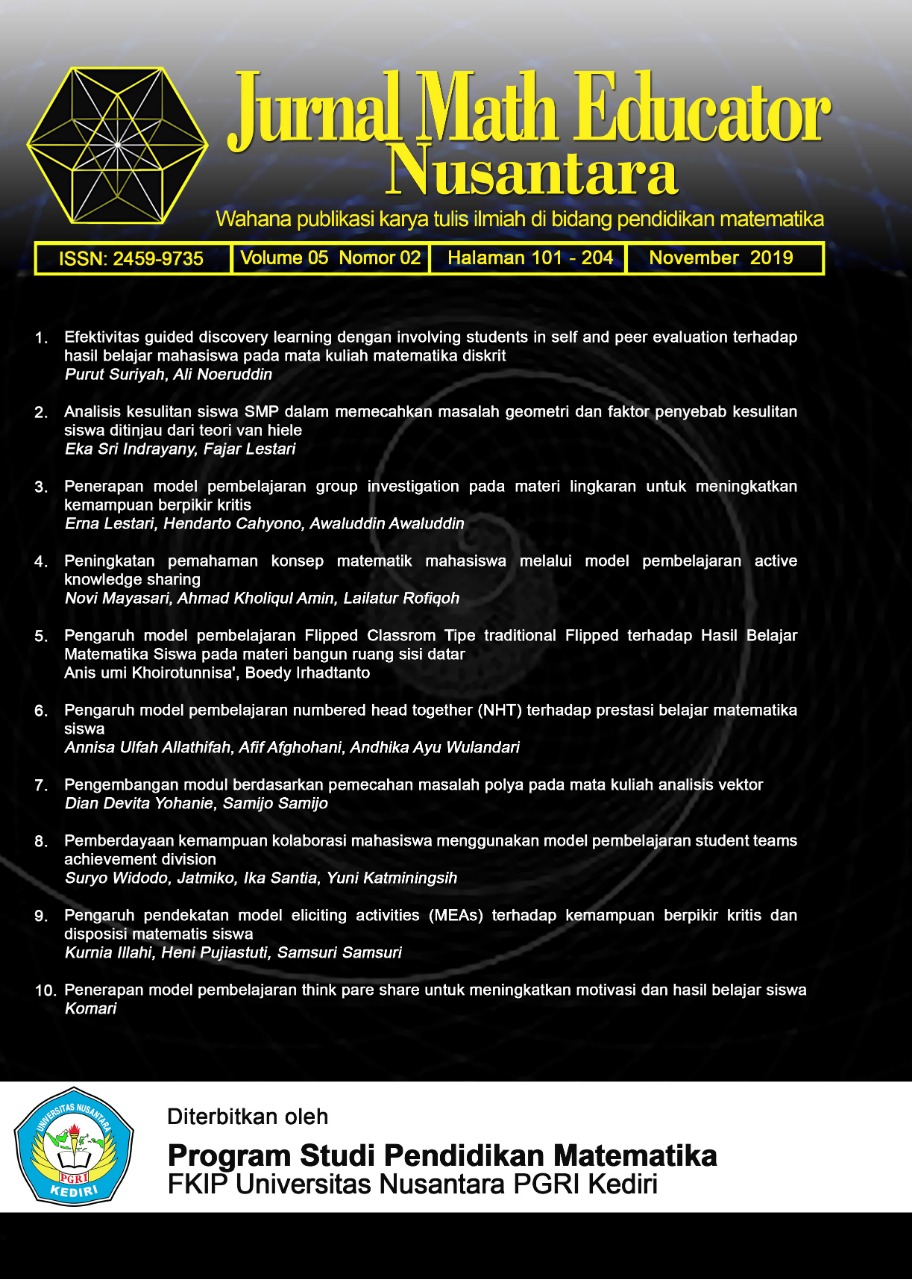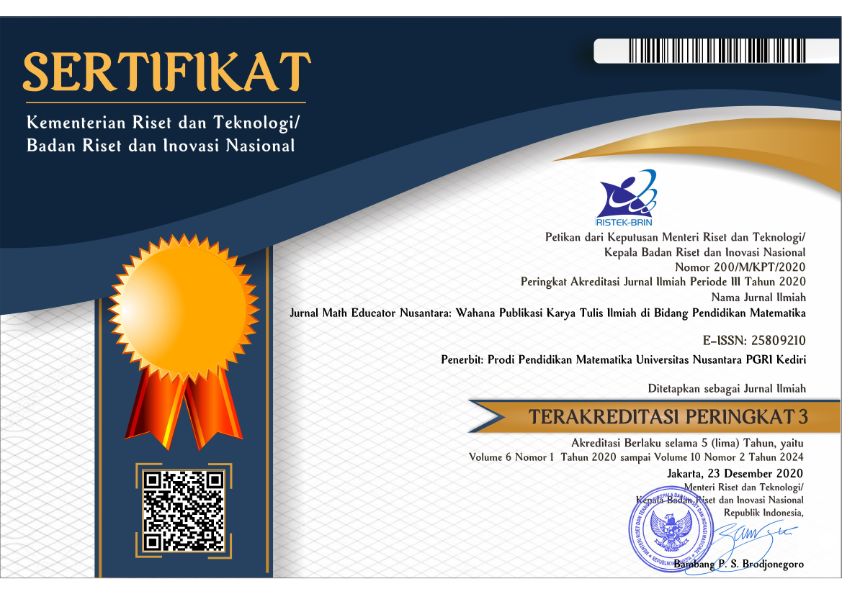Pengaruh pendekatan model eliciting activities (MEAs) terhadap kemampuan berpikir kritis dan disposisi matematis siswa
DOI:
https://doi.org/10.29407/jmen.v5i2.12891Keywords:
Model Eliciting Activities, MEAs, Berfikir Kritis, Disposisi, Sistem Persamaan Dua VariabelAbstract
This research is motivated by mathematical critical thinking abilities and low student dispositions, and students are less able to find other alternatives in solving the questions given by the teacher. The purpose of this study is to find out the critical thinking skills of students who get learning using MEAs better than in students who get conventional learning. And to find out the mathematical disposition of students who get learning using MEAs better than students who get conventional learning. This research was conducted at Panimbang 3 Public High School. The sample in this study was class VIII. This research method uses quasi experiments. The instrument used was a critical ability test, and a mathematical disposition scale. The results of this study show that the critical mathematical thinking skills of students who get learning using the Model Eliciting Activities MEAs model are better than students who get conventional learning. And the mathematical Disposition of students who get learning using Model Eliciting Activities MEAs is better than students who get learning conventional.
References
BSNP. (2006). Permendiknas RI No. 22 Tahun 2006 tentang Standar Isi untuk Satuan Pendidikan Dasar dan Menengah. Jakarta.
Chamberlin, S. A., & Moon, S. M. (2008). How does the problem based learning approach compare to the model-eliciting activity approach in mathematics. International Journal for Mathematics Teaching and Learning, 9(3), 78-105.
Dzulflkar, A., Asikin, M. dan Hendikawati, P. (20I2). Keefektifan Problem Based Learning dan Model Electing Activities terhadap Kemampuan Pemecahan Masalah. Unnes Journal of Mathematics Education, 1(1), 1-6. https://doi.org/10.15294/ujme.v1i1.252
Haryani, D. (2011). Pembelajaran matematika dengan pemecahan masalah untuk menumbuhkembangkan kemampuan berpikir kritis siswa. In Prosiding Seminar Nasional Penelitian, Pendidikan dan Penerapan MIPA, FMIPA, UNY pada (Vol. 14, pp. 121-26).
Istianah, E. (2013). Meningkatkan kemampuan berpikir kritis dan kreatif matematik dengan pendekatan model eliciting activities (MEAS) pada siswa SMA. Infinity Journal, 2(1), 43-54. DOI: https://doi.org/10.22460/infinity.v2i1.p43-54
Istivaiyah, I. (2013). Penerapan Model Pembelajaran Kooperatf Tipe CO-OP CO-OP untuk Meningkatkan Kemampuan :komunikasi dan Disposisi Matematis Siswa. Skripsi FKIP Untirta Serang tidak diterbitkan.
Lestari, K. E., & Yudhanegara, M. R. (2015). Penelitian Pendidikan Matematika. Bandung: PT. Refika Aditama
Oktaviani, R. (2015). Keefektifan Model-Eliciting Activities Berbantuan LKPD Terhadap Kemampuan Komunikasi Matematis Dan Disposisi Matematis Peserta Didik Kelas VIII (Doctoral dissertation, Universitas Negeri Semarang).
Permana, Y. (2010). Mengembangkan kemampuan pemahaman, komunikasi, dan disposisi matematis siswa sekolah menengah atas melalui Model-Eliciting Activities (Doctoral dissertation, Universitas Pendidikan Indonesia).
Sanjaya, W. (2011). Strategi Pembelajaran Berorientasi Standar Proses Pendidikan. Jakarta: Kencana Prenada Media Grup
Siregar, S. (2010). Statistika deskriptif untuk penelitian. Jakarta: Rajawali Pers.
Yildirim, T. P., Shuman, L., Besterfield-Sacre, M., & Yildirim, T. P. (2010). Model eliciting activities: assessing engineering student problem solving and skill integration processes. International Journal of Engineering Education, 26(4), 831-845.
Widyastuti. (2010). Pengaruh Pembelajaran Model Eliciting Activties Terhadap Kemampuan Representasi Matematika dan Self- Efficacy Siswa. Tesis. Tidak diterbitkan. UPI Bandung.
Downloads
Published
Issue
Section
License
Authors who publish with this journal agree to the following terms:
- Copyright on any article is retained by the author(s).
- The author grants the journal, the right of first publication with the work simultaneously licensed under a Creative Commons Attribution License that allows others to share the work with an acknowledgment of the work’s authorship and initial publication in this journal.
- Authors are able to enter into separate, additional contractual arrangements for the non-exclusive distribution of the journal’s published version of the work (e.g., post it to an institutional repository or publish it in a book), with an acknowledgment of its initial publication in this journal.
- Authors are permitted and encouraged to post their work online (e.g., in institutional repositories or on their website) prior to and during the submission process, as it can lead to productive exchanges, as well as earlier and greater citation of published work.
- The article and any associated published material is distributed under the Creative Commons Attribution-ShareAlike 4.0 International License
















